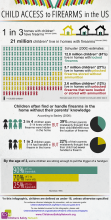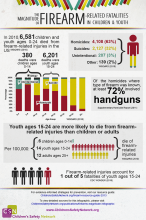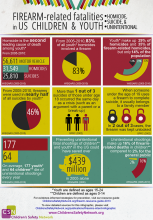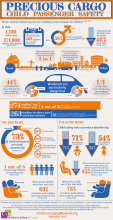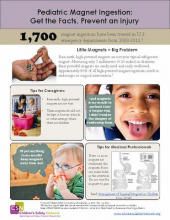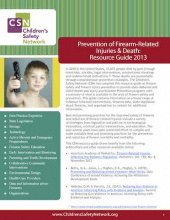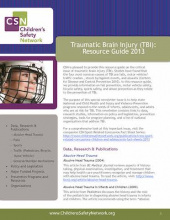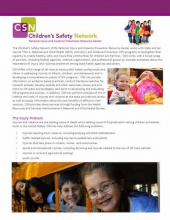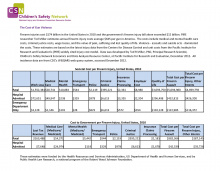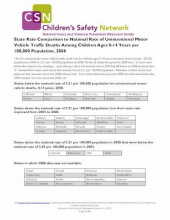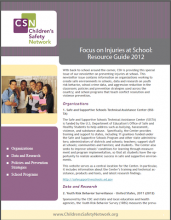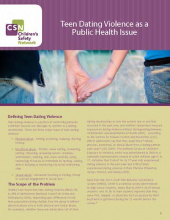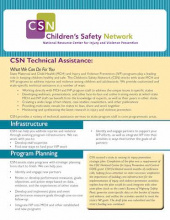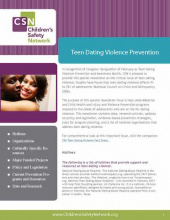CSN Publications
![]() This page displays all Children’s Safety Network (CSN) publications sorted by date released. Please feel free to download and share through Facebook, X, Pinterest, or email.
This page displays all Children’s Safety Network (CSN) publications sorted by date released. Please feel free to download and share through Facebook, X, Pinterest, or email.
Released Date:
The following fact sheet provides information about firearm-related injuries and deaths among 15 through 24 year olds in the United States. It contains a review of data and information about the magnitude of the problem, shows how different demographic groups are impacted,…
Read MoreReleased Date:
Children often find or handle firearms in the home without their parents' knowledge. In the United States, 2,600,000 children live in homes with unlocked firearms that are stored loaded or with ammunition. Child Access to Firearms in the US discusses the number of children who have firearms in…
Read MoreReleased Date:
218,851 playground-related injuries are treated in an emergency department each year. This infographic breaks down playground-related injuries by hazard, diagnosis, equipment, and age and sex. Additional resources on playground safety can be found in the text below. Click here for the print…
Read MoreReleased Date:
In 2010, 6,581 children and youth ages 0-24 died from firearm-related injuries in the US. The Magnitude of Firearm-Related Fatalities in Children and Youth breaks down the firearm-related fatalities of children and youth by age and intent. This is the second infographic in a three-part series…
Read MoreReleased Date:
This infographic covers three types of firearm-related injuries and how they affect children and youth: homicide, suicide, and unintentional. This is the first in a three-part series of infographics about firearms. The other infographics in the series are available here: The Magnitude of…
Read MoreReleased Date:
WALKING SAFE: Child Pedestrian Safety Every year:* 67,124 child** pedestrians are fatally or nonfatally injured(WISQARS, 2005-2010) Children ages 15-19 suffer the most pedestrian injures (WISQARS, 2005-2010) Age Group Average Fatal and Nonfatal Injuries per Year 0-4 yrs 6,456 5-9 yrs 12,…
Read MoreReleased Date:
Though child passenger fatalities have decreased, motor vehicle-related injuries are still a leading cause of death for children. Proper use of child restraints can significantly reduce the risk of injury and death for children. Unfortunately, many child restraints are used incorrectly. This…
Read MoreReleased Date:
Powerful, rare earth (neodymium) magnets can cause serious injury and death when ingested. The CPSC (Consumer Product Safety Commission) has reported an estimated 1,700 ingestions of magnets that were treated in emergency departments between Jan. 1, 2009 and Dec. 31, 2011. These injuries are…
Read MoreReleased Date:
New attention is being paid to the short- and long-term effects of even mild concussions as interest in and knowledge of the dangers of sport-related concussions have increased. In a review of state 2012 MCH Block Grant applications, the Children’s Safety Network found that 31 states described…
Read MoreReleased Date:
This resource was recently updated. Visit the latest version. The Children’s Safety Network (CSN) has compiled this resource guide on Firearm Safety and Firearm Violence Prevention to provide state Maternal and Child Health and Injury and Violence Prevention programs with a summary of what…
Read MoreReleased Date:
This resource was recently updated. Visit the latest version. CSN is pleased to provide this resource guide on the critical issue of traumatic brain injury (TBI). Studies have found that the four most common causes of TBI are falls, motor vehicle/traffic crashes, struck by/against events,…
Read MoreReleased Date:
Firearm injuries cost $174 billion in the United States in 2010 and the government's firearm injury bill alone exceeded $12 billion. PIRE researcher Ted Miller estimates annual firearm injury costs average $645 per gun in America. The costs include medical and mental health care costs,…
Read MoreReleased Date:
CSN released this infographic on all-terrain vehicles (ATVs), which includes information on ATV-related fatalities, ATV risk factors, and ATV safety tips. Print version of ATV Infographic
Read MoreReleased Date:
In recognition of Suicide Prevention Week, September 9-15, 2012, and with the launch of the newly updated National Action Plan for Suicide Prevention, CSN has updated our resource guide on the critical issue of youth suicide prevention. Suicide is the 4th leading cause of death among youth 10 - 24…
Read MoreReleased Date:
Contains the following maps: State Rate Comparison to National Rate of Unintentional Motor Vehicle Traffic Deaths Among Children Ages 0-14 Years per 100,000 Population, 2008 State Rate Comparison to National Rate of Suicide Deaths among Youth Ages 15-19 Years per 100,000 Population, 2008
Read MoreReleased Date:
With back-to-school around the corner, CSN is providing this special issue of our newsletter on preventing injuries at school. This newsletter issue contains information on organizations working to create safe environments in schools, data and research on youth risk behavior, school crime data, and…
Read MoreReleased Date:
This fact sheet provides information and data on teen dating violence, describes evidence-informed interventions to reduce teen dating violence behavior, offers examples of state efforts to prevent dating violence, and lists specific steps that public health professionals can take to play an active…
Read MoreReleased Date:
In recognition of Congress' designation of February as Teen Dating Violence Prevention and Awareness Month, CSN is pleased to provide this special newsletter on the critical issue of teen dating violence. Studies have found that teen dating violence affects 9% to 35% of adolescents (National…
Read More
